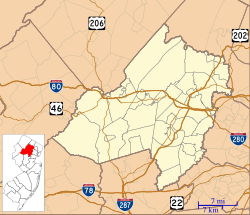
Morris County is a county located in the U.S. state of New Jersey, about 30 mi (48 km) west of New York City. According to the 2020 census, the county was the state's tenth-most populous county, with a population of 509,285, its highest decennial count ever and an increase of 17,009 (+3.5%) from the 2010 census count of 492,276, which in turn reflected an increase of 22,064 (+11.6%) from the 470,212 counted in the 2000 census, Morris County is part of the New York metropolitan area and is divided into 39 municipalities, with many commuter towns but no large cities. Its county seat is Morristown, in the southeast. The most populous place was Parsippany-Troy Hills Township, with 56,162 residents at the time of the 2020 census, while Rockaway Township covered 45.55 square miles (118.0 km2), the largest total area of any municipality. The county is part of the North Jersey region of the state.
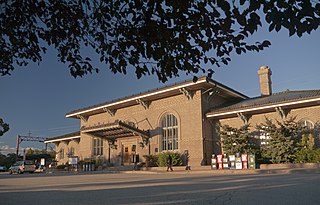
Morristown is a town and the county seat of Morris County, in the U.S. state of New Jersey. Morristown has been called "the military capital of the American Revolution" because of its strategic role in the war for independence from Great Britain. Morristown's history is visible in a variety of locations that collectively make up Morristown National Historical Park, the country's first National Historical Park.
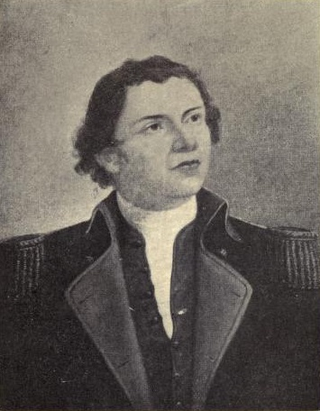
Hugh Mercer was a brigadier general in the Continental Army during the American Revolutionary War. He fought in the New York and New Jersey campaign and was mortally wounded at the Battle of Princeton.

Morristown National Historical Park is a United States National Historical Park, headquartered in Morristown, New Jersey, consisting of four sites important during the American Revolutionary War: Jockey Hollow, Ford Mansion, Fort Nonsense, and Washington's Headquarters Museum.
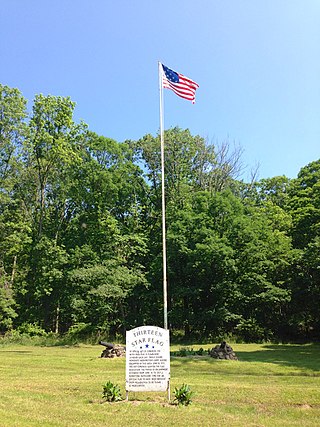
"Middlebrook encampment" may refer to one of two different seasonal stays of the Continental Army in central New Jersey near the Middlebrook in Bridgewater Township in Somerset County. They are usually differentiated by either the date of the encampment or their chronological order.

New Jersey played a central role in the American Revolution both politically and militarily. It was the site of more than 90 military engagements, including the pivotal battles of Trenton, Princeton, and Monmouth. George Washington led his army across the state four times and encamped there during three hard winters, enduring some of the greatest's setbacks of the war as well as seminal victories. New Jersey's decisive role in the conflict earned it the title, "Crossroads of the American Revolution".

New Bridge was a prosperous mill hamlet, centered upon a bridge strategically placed at the narrows of the Hackensack River. In the American Revolution, New Bridge Landing was the site of a strategic bridge crossing the Hackensack River, where General George Washington led his troops in retreat from British forces November 20, 1776. Eleven engagements took place here throughout the war. The current Draw Bridge at New Bridge was installed in 1889 and added to the National Register of Historic Places on July 5, 1989. The area is now a New Jersey historic site in portions of New Milford, River Edge, Hackensack and Teaneck in Bergen County, New Jersey.
The 2nd New Jersey Regiment was raised, on 9 October 1775, at Trenton, New Jersey, for service with the Continental Army under the command of Colonel William Maxwell. The regiment would see action at the Battle of Trois-Rivières, Battle of Valcour Island, Battle of Brandywine, Battle of Germantown, Battle of Crooked Billet, Battle of Monmouth, Sullivan Expedition, Battle of Springfield and the Battle of Yorktown. The regiment was furloughed, on 6 June 1783, at Newburgh, New York, and disbanded 3 November 1783.

Jockey Hollow is the name for an area in southern Morris County, New Jersey farmed in the 18th century by the Wick, Guerin and Kemble families. The origin of the name is still uncertain, but was used as such at the time of the American Revolution. For most of the Revolutionary War, it was used by portions of Continental Army as a winter camp site, and it housed the main Continental Army during the "Hard Winter" of 1779–80, believed to be the harshest winter in recorded history.

Pennsylvania was the site of many key events associated with the American Revolution and American Revolutionary War. The city of Philadelphia, then capital of the Thirteen Colonies and the largest city in the colonies, was a gathering place for the Founding Fathers who discussed, debated, developed, and ultimately implemented many of the acts, including signing the Declaration of Independence, that inspired and launched the revolution and the quest for independence from the British Empire.

The Ford Mansion, also known as Washington's Headquarters, is a classic 18th-century American home located at 30 Washington Place in Morristown, New Jersey that served as General George Washington's headquarters from December 1779 to June 1780 during the American Revolutionary War.

The Somerset Hills is known as the northern region of Somerset County located in the U.S. state of New Jersey and includes the municipalities of Bedminster, Bernardsville, Bernards Township, Far Hills, and Peapack-Gladstone. The southwestern Morris County municipalities of the Chesters and the Mendhams are periodically recognized as part of the Somerset Hills.
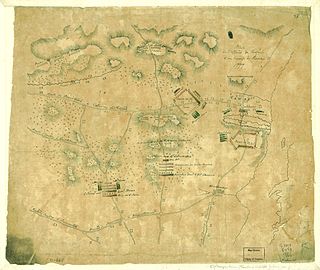
The Battle of the Short Hills was a conflict between a Continental Army force commanded by Brigadier General William Alexander, and an opposing British force commanded by Lieutenant General William Howe. The battle took place on June 26, 1777, at Scotch Plains and Edison, New Jersey, during the American Revolutionary War.

Valley Forge was the winter encampment of the Continental Army, under the command of George Washington, during the American Revolutionary War. The Valley Forge encampment lasted six months, from December 19, 1777 to June 19, 1778. It was the third and harshest of the eight winter encampments that Washington and the Continental Army endured during the war.

Fort Billingsport, referred to as Fort Billings in some sources, was a Continental Army fort in Billingsport in Paulsboro, New Jersey in Gloucester County, New Jersey, during the American Revolutionary War. The site of the fort is now a public park of the same name, located at the Plains Terminal at the Port of Paulsboro between two oil refineries.
Events from the year 1777 in the United States.

Morristown Green, most commonly referred to as the Green, is a historical park located in the center of Morristown, New Jersey, United States. It has an area of two and a half acres and has in the past served as a military base, a militia training ground, and an area for public executions. It is now a public park in which many community events are held. It was added to the National Register of Historic Places, listed as a contributing property of the Morristown District, on October 30, 1973.
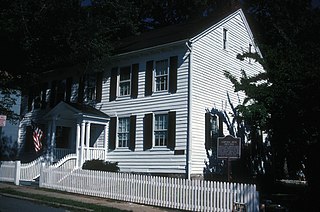
The Dr. Jabez Campfield House, also known as the Schuyler Hamilton House, is a historic, two-story, braced timber-frame colonial Georgian-style house and museum located at 5 Olyphant Place, Morristown, New Jersey.
Dr. Jabez Campfield was a colonial-era doctor, one of the earliest to set up practice in Morristown, New Jersey. He served as a surgeon in the Continental Army during the American Revolutionary War. During the Continental Army's winter encampment in Morristown in 1777, Dr. Campfield helped inoculate soldiers against a smallpox outbreak that spread through the army and the area that winter. Dr. Campfield was a surgeon on the Sullivan Expedition in upstate New York in the summer and autumn of 1779, during which he kept a detailed diary which has been preserved and published. During the winter encampment of 1779-1780, surgeon general Dr. John Cochran stayed in Dr. Campfield's home, and his home served as a "flying hospital". Dr. Cochran's niece, Elizabeth Schuyler, came to stay in Dr. Campfield's home, and while there fell in love and became engaged to Founding Father Alexander Hamilton.
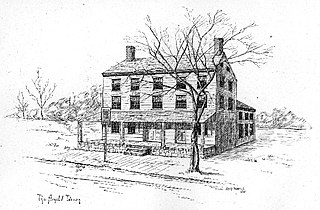
Jacob Arnold's Tavern, also known as the OldArnold Tavern and the Duncan House, was a "famous" historic tavern established by Samuel Arnold circa 1740. Until 1886, it was located in Morristown Green in Morristown, New Jersey. In 1777 it served as George Washington's headquarters during the Revolutionary War, and it was the site of Benedict Arnold's first trial in 1780. The National Park Service claims "Much of [Morris]town's social, political, and business life was conducted at Arnold's Tavern" during the Revolutionary era.

